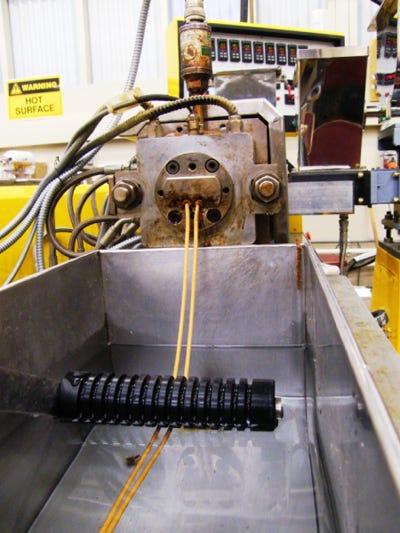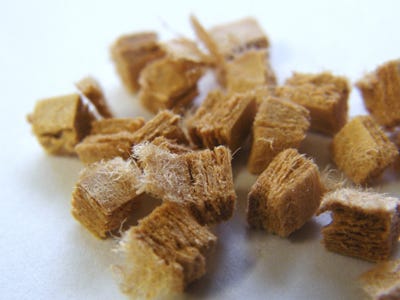Wood-filled thermoplastic composites are nothing new. They made a first appearance in the early 1980s, with limited success as most early products failed to live up to expectation. However, things have changed markedly since the time when scratching, sagging, warping, splintering, and delaminating were still major challenges that needed to be overcome.
June 15, 2012
Wood-filled thermoplastic composites are nothing new. They made a first appearance in the early 1980s, with limited success as most early products failed to live up to expectation. However, things have changed markedly since the time when scratching, sagging, warping, splintering, and delaminating were still major challenges that needed to be overcome.
A new report by the Hackwell Group (its third on this subject) forecasts continuing growth to almost 360,000 tons by 2015, representing an average annual growth of 13%. Although growth has slowed compared with the 2005-10 period because of current economic woes, the outlook remains good. Or at least good enough for Sonae Industria, a leading global player in the wood industry, to introduce WoodForce, a product that the company claims is strong enough to replace glass fiber in short fiber applications, while offering a novel approach to the compounding of natural fiber-reinforced thermoplastics.
|
So what is WoodForce, and particularly, what makes it so “novel”? After all, natural fiber-reinforced thermoplastics abound. Rice, wheat, kenaf, hemp, and many others have all been used as natural fillers, with various degrees of success. In an interview with Christophe Chambonnet, WoodForce’s Canada-based global manager, however, it became clear that WoodForce really did have something new to offer.
“It’s important to realize that we’re a wood company, one of the largest producers of wood-based panels—MDF, particle board, and the like—in the world,” he explained. “And right now, with the construction industry in such poor shape, we decided we needed to take our product into ‘a new world’: the plastics industry. And we realized that a modification of the MDF process was the perfect way to achieve this.”
MDF, or Medium Density Fiberboard, is made of wood waste fibers—very fine chips and sawdust—that are refined, i.e. separated into individual fibers, then bonded with resin (which contains formaldehyde) under heat and pressure, and pressed into boards. To make WoodForce, the same process is followed. A patented technology has been developed, in which lignin acts as the glue and a (polymer) dispersing agent (content 1%) is added to prevent the fibers from settling and clumping. The pressed board is then diced into pellets for precise dosing during compounding.
“WoodForce is therefore wood—and nothing but wood,” says Chambonnet. “But because the fibers have been refined and are perfectly dispersed, the normal problems that occur with natural fibers during compounding are eliminated.” The compounding process is best done in a co-rotating twin-screw extruder, where the dispersing agent ensures an even distribution of the fibers throughout the thermoplastic matrix. “No special equipment is necessary; compounders can use conventional dosing and extrusion equipment with no problem,” he added.
Another advantage is the fact that, unlike when using wood flour, dust is not an issue. During the production of the WoodForce pellets, dust extraction equipment ensures that dust is removed, to avoid health and combustible dust explosion hazards.
The wood used to produce WoodForce is sourced locally, all year round, from responsibly managed forests and post-industrial wood products. “Our life cycle analysis shows that overall, we have a relatively clean process regarding energy and raw material”, says Chambonnet. “The energy content is about 12% of the production cost—much lower than, for example, glass fiber. And the product has a much better recyclability, as well. It’s clean, and green.”
WoodForce will be starting up commercial-scale production in a few weeks in Europe. The technology is a global one: wherever MDF is produced, WoodForce can also be manufactured. The next step will be a plant in North America, and then, Asia. “We’ll be looking for existing MDF facilities. After that, it’s a matter of buying a granulator to make the pellets,” says Chambonnet, who added that the response to the product has been good. “Compounders are our customers. We’ve been working with several to test the product, and now have several lined up. Rhetech, PolyOne, RTP, So.F.TER. SPA, Albis are just a few of the companies we’ve worked with.”
Marcel Dartée, global marketing director biomaterials at PolyOne Corporation confirms that his company is enthusiastic. “WoodForce is one of the few natural fibers that has managed to solves the challenges of odor and fungal growth. Both are important preconditions for use in durable applications. This opens the doors for glass-fiber replacement for more durable applications, such as the automotive and the electronics industry. That’s where we definitely see possibilities.”
Also, the product has attracted interest from OEMs, especially in the automotive industry—a positive development, since enthusiasm “at the end of the chain” will help convince molders. Chambonnet: “WoodForce is a natural fiber without constraints on supply. It’s a lightweight alternative for glass. Plus, we can add carbon black to the fibers, which stains them black. After compounding, the fibers are invisible. This makes the product suitable for black visible part applications. This is something automakers have been looking for, and we expect this to become a large portion of our business.”
Curious to hear what a molder who had tested WoodForce had to say, PlasticsToday was put into contact with Nuno Gonçalves, R&D manager at Simoldes Plásticos SA in Portugal, a supplier of automotive components for the most important OEMs and a "major supplier" of PSA Peugeot Citroën.
Gonçalves explained that currently, the most important guidelines for the automotive industry are sustainability commitments, such as the EU’s firm independent commitment to achieve at least a 20% reduction of greenhouse gas emissions by 2020 compared to 1990 and compliance with EU legislation requiring European car manufacturers to cut average tailpipe CO2 emissions from new cars to 130g/km by 2015 and about 95g/km by 2020. Meeting these commitments requires the industry to take responsibility to deliver ongoing improvements.
“The solution as we see it is to build lighter vehicles, develop alternative energy technology—and of course the speed limit,” says Gonçalves, whose company has worked intensively on solutions to improve automotive sustainability since 2008. This has included testing numerous green materials, including wood composites like WoodForce.
According to Gonçalves, “WoodForce is one of the best ways to meet the proposed targets in the green and light materials solutions for automotive interior components. From the point of view of an automotive plastics components producer, the advantages are product quality; the fiber properties and performance are like non-natural reinforcement on the polymer subtract. The achieved weight reduction of final parts compared to other loaded compounds is extremely favorable. And we are very excited about the possibility to color the fibers before mixing in the compound, which solves one of the common aesthetic problems.”
Up until now, the trials performed at Simoldes Plásticos have yielded very satisfactory results regarding the injection process and technical requirements of the compound. The company greets this kind of innovative solution that covers the main objectives of weight reduction and green materials with enthusiasm. “Using this kind of material, Simoldes Plásticos can offer an innovative solution to the OEMs, and align with the OEMs to face the sustainability challenge,” said Gonçalves.
All in all, Sonae Industria’s foray into the plastics industry looks to be set for success. If WoodForce delivers on its promise, it will, indeed, be a natural force to be reckoned with in the industry.
About the Author(s)
You May Also Like




